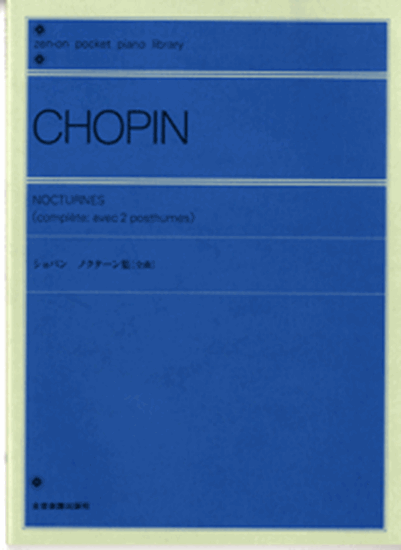Chopin, Frederic : Nocturne No.17 H-Dur Op.62-1
Work Overview
Genre:nocturne
Total Playing Time:6 min 00 sec
Copyright:Public Domain
Commentary (1)
Author : Ueda, Yasushi
Last Updated: January 1, 2010
[Open]
Author : Ueda, Yasushi
Deux Nocturnes Op.62
These two pieces were composed in 1846 and first published in Paris (Brandus, 1846), Leipzig (Breitkopf und Härtel, 1846), and London (Wessel, 1846). They are dedicated to Miss R. von Heygendorff-Kenneritz, who is believed to have been his pupil. These are the last nocturnes Chopin published during his lifetime. Compared to the two pieces of Op. 55, the writing becomes increasingly polyphonic, and the chromatic undulations disappear, making the sonority more transparent. At this point, he seems to have found his own answer, reconciling the polyphonic writing he had always yearned for with a cantabile style.
No. 1 in B Major
No. 1, like many other nocturnes, is in ternary form, schematized as A-B-A'. Similar to Op. 55-2 (No. 16), it begins with an abrupt, cadenza-like opening. The chord placed at the beginning is a II chord with an added seventh. This seemingly peculiar opening likely stems from the custom of a “prelude,” which was common at the time. A “prelude” was a short, improvisatory introduction performed before a piece to draw the listener's attention to the performer or to check the touch, and it was common until the early 20th century. Such “preludes” can be heard in live recordings by Backhaus and Josef Hofmann. However, why did Chopin bother to notate it? This is a question worth examining, but we will not discuss it here.
The theme that follows the “prelude” is a pseudo-polyphony with an indeterminate number of voices. The opening section of this piece, as often seen in Baroque fugues, has an irregular meter. The theme appearing on the third beat of the first measure, when it reappears in measure 7, is on the first beat. The descending motif of this theme is utilized in the inner voice of the right hand from measures 11 to 14. Ensuring consistency through such motifs is a major characteristic of fugal writing, exemplified by Bach, and Chopin was likely strongly aware of it. From measures 14 to 21, the right hand consistently moves in two voices, in eighth notes. From a technical standpoint, such multi-voice movement is a relatively old piano writing style, first employed by predecessors active in the early 19th century, such as Clementi and Cramer. The subsequent transitional measures 21 to 25 feature the syncopated rhythmic ostinato that will be used in section B. The theme then returns, leading into the middle section B in A-flat major. The trill that first appears in B is then utilized in the theme's recapitulation in A' (measures 68-75). This technique of weaving a melody into a trill was a fashionable technique, often used by virtuoso pianists and composers like Döhler in the late 1830s and 1840s. Chopin thus actively incorporated not only old techniques but also the latest trends.
When the theme settles on the dominant seventh of the remote key of G major in measure 75, a skillful four-measure transitional passage follows (measures 76-80) to return to B major. Here, the four voices are treated particularly contrapuntally, making this a meticulously written section. In the coda, beginning at measure 81, the syncopated rhythmic ostinato in the left hand returns, while the right hand floats an somewhat “exotic” scale containing an augmented second, and the piece concludes in a dreamlike atmosphere.
PTNA & Partner Channel Videos(10items) View More
Sheet Music
Scores List (13)

(株)全音楽譜出版社

(株)全音楽譜出版社

ハンナ(ショパン)

(株)ドレミ楽譜出版社

(株)音楽之友社

(株)全音楽譜出版社

(株)音楽之友社

(株)全音楽譜出版社

(株)全音楽譜出版社

(株)全音楽譜出版社

ポーランド音楽出版社

(株)ヤマハミュージックエンタテインメントホールディングス

(株)音楽之友社










